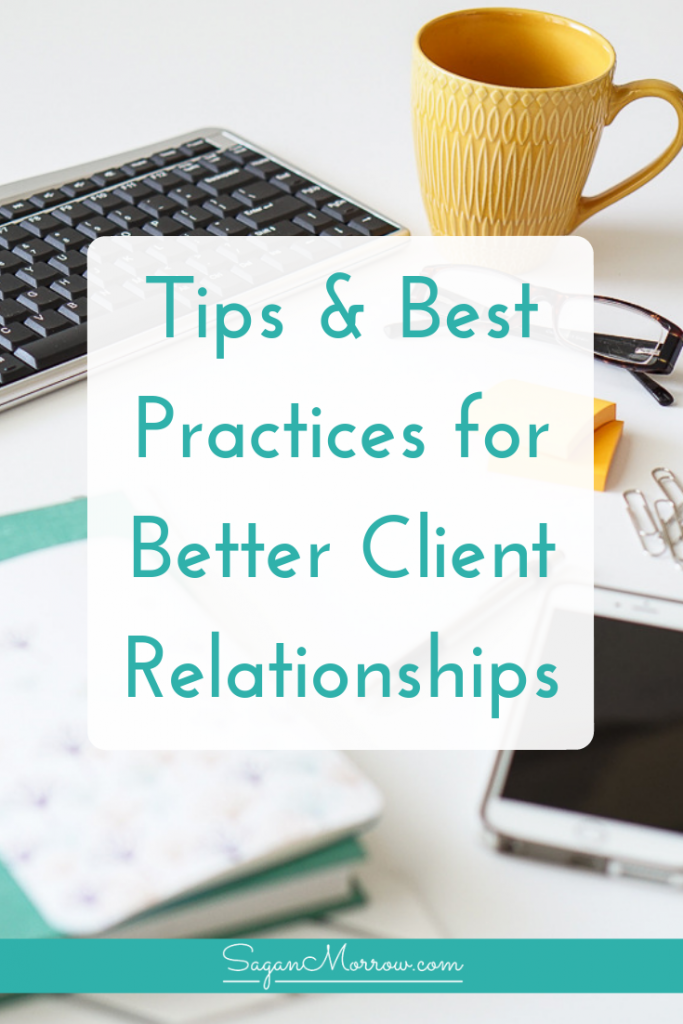Once you’ve marketed your business, built a relationship, pitched your services, and been hired by clients, it doesn’t end there. You need to maintain strong, positive client communications throughout your work together if you want to have a successful and enjoyable relationship with your clients.
Keep in mind that it should be a positive relationship with clear communication lines on both ends. The good news is that when you follow these client communication tips and best practices, you'll help your client to communicate better, too... and ultimately improve all of your client relationships!
The first thing you’ll want to do is be very clear upfront about what the scope of the project involves:
- What are the client’s expectations for you?
- What are your expectations of the client?
- What specific deliverables are you providing with this project?
- What is the deadline for this project?
- What does the payment timing and method look like?
Clarity is crucial to avoid misunderstanding or miscommunications down the line. Get these five questions answered at the beginning of the project so that you don't have to ask awkward questions later on, and so that you both have a solid understanding about each of your expectations around what the project will look like.
Unfortunately, many clients don't have a specific deadline in mind... making it tricky for you to know exactly when you should get the finished project to them. Plus, negotiating rates with clients can be a major challenge for many freelancers!
That's why, in Productivity Powerhouse, lessons cover topics such as how to improve time management and navigate deadlines (especially when you're juggling multiple projects).
The second thing to do is be clear about how you will communicate with one another. This includes:
- Preferred methods of communication (for example, email, phone, Facebook messaging, Google Hangout chat system, Skype, etc.)
- Frequency of connecting for project updates (do they want you to give them daily/weekly updates? Do you want them to send you a separate email for each question they have?)
- Expectations of project updates (what components of the project do you/they want to know about in the updates?)
Get all of these things in writing, if possible, so that both you and your client know exactly what to expect from one another for the duration of the project. Having everything in writing enables you both to refer back to it as needed. It also helps to have project details in writing so that there aren’t any misunderstandings about the expectations on both of your parts. 
These things are also extremely important to have in place early on in order to set boundaries for clients.
When you build strong relationships with clients, and when you start to have repeat work with the same clients, you might find that your freelancer-client relationship gets pretty informal and perhaps rather friendly. You might even become good friends out of it! But the problem with this can be that clients stop respecting your personal space and boundaries.
Be careful about maintaining boundaries when it comes to your work life, or you might find yourself getting taken advantage of (regardless of whether or not that is your client's intention).
Once you’ve built strong communication habits in the beginning, be sure to continue to maintain them throughout your entire freelancer-client relationship. Keep communication lines open and if you are uncertain about anything, discuss it with them immediately so as to avoid misunderstandings.
Treat your relationship with clients the same as you would any other relationship: have a strong, healthy communicative foundation.
Preferred methods of communication
There are many different ways to communicate with clients. One isn’t necessarily better than another---they’re just different, and everyone will have their own preferences.
As discussed above, be clear upfront about what kind of communication methods are and are not preferred. If you’re not sure about which communication method(s) you should use, here’s a breakdown of the pros and cons of the four most common communication methods:
Pros:
- You can plan out what you want to say in advance and be very strategic about your wording
- Gives you a written record to refer back to in the future
- More opportunity to get into much greater detail about the project and can add other files (e.g. photos, videos, etc.)
- Easy to cc, bcc, or forward details on to another team member who needs to be kept in the loop
Cons:
- May take clients a long time to respond
- You don’t know whether they received your email or if it went to spam or got lost in their inbox
- Easy to misinterpret things if you or they aren’t careful about the wording used
- Depending on their communication style/voice, it can be difficult to really get to know each other and/or interpret tone the way it was intended
Phone (or Skype)
Pros:
- Discussing issues in real time saves a lot of back-and-forth communication
- You can ask clients to repeat their wants so everything is very clear
- Gives clients an opportunity to “get to know you” even across great distances
- Can sometimes be a much faster way to get information across
Cons:
- Client may call you at any time, leaving you unprepared
- Anything you discuss or agree upon will need to be translated into writing afterward
- Possibility that one of you will miss out on important details
- Could be costly if you don’t have a good phone plan
In-person meetings
Pros:
- Good opportunity to get to know each other very quickly
- Can discuss the project in minute detail
- Gets you outside, into the real world, and away from your computer (something that can be particularly welcome when we work from home alone!)
- Because conversation might move away from solely the topic at hand, you might be able to get more business opportunities or project ideas throughout your conversation
Cons:
- Agreements and project details will need to be translated into writing afterward
- One or both of you might miss something or forget something vital if you aren’t diligent about taking notes
- Could take a great deal of time out of your day
- If you aren’t well-prepared, you might get stuck when they start asking you more detailed questions
Text messaging (or Google Hangouts, or Facebook messenger)
Pros:
- Client can send you urgent information or requests immediately
- Easy to ask/respond to quick, straightforward questions
- Informality can build a nice sense of camaraderie
- Can save a lot of time
Cons:
- Increased chance of misunderstandings because of the informal nature of the platform
- Client may overstep personal boundaries by contacting you at all hours of the day/week and unreasonably expect you to get back to them right away
- Easy to forget to respond if you don’t deal with it immediately
- Can be difficult to balance professionalism with informality
Encourage clients to use your preferred communication methods
Lead by example to encourage your clients to communicate with you in your preferred method: if you prefer that they phone you, then always phone them when you need to discuss something with them, for example. If they tend to use a form of communication that you don’t want them to use, you can outright ask them not to communicate with you that way, or you can more subtly respond by using a different platform.
For example, if a client often texts you, but you prefer that they email you, then every time they text you something about the project you might choose to respond via email instead. To ensure they've received your message or if you're nervous about how they might take it, you can even send them a quick text after you email them to let them know you sent them a fulsome answer in an email. They'll appreciate that you responded to them and it will help them get the hint that email is a better platform for discussing projects.
Want to learn more about how to best communicate with clients?
Improve your solopreneur business practices inside the Productivity Powerhouse e-course!
You'll learn...
- How to create a business plan you actually use (no more boring, jargon-heavy, dust-gathering documents)
- Best practices for creating systems, processes, and strategies that are PERFECT for your unique situation.
- How to navigate work/life balance with ease (even as your client roster grows)
- Task list management, recalibration methods, gamification techniques, and other strategies for getting more done in less time.
- How to manage deadlines and a busy schedule.
- ...and more!

Excellent post and so important. One I think a lot of editors, proofreaders and writers need to take more seriously! I recently tried to hire an editor and ultimately gave up (for the time being) because the folk I interviewed had zero processes in place and wasted so much of my time with back and forth emails! My ideal editor would say: “Look, this is how I work, this is what I charge, this is how I bill, etc.”
Personally, I start all client work with a call in which I clarify my client’s goals and I explain my process. I then use email for follow-up. I work remotely, so generally do not meet in person. Occasionally, I will arrange follow-up calls or video calls to clarify.
I also use a “How I work” document to clarify expectations up-front. And, I consider that initial call a “client interview.” I only work with clients that can respect my processes, because that tells me upfront if we will have a positive or a negative client work experience.
Thanks, Alison!
Love your process — it can make SUCH a huge difference to clarifying things and ensuring an awesome working relationship.
[…] Learn more about communicating effectively with clients […]